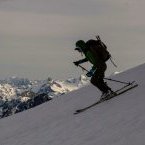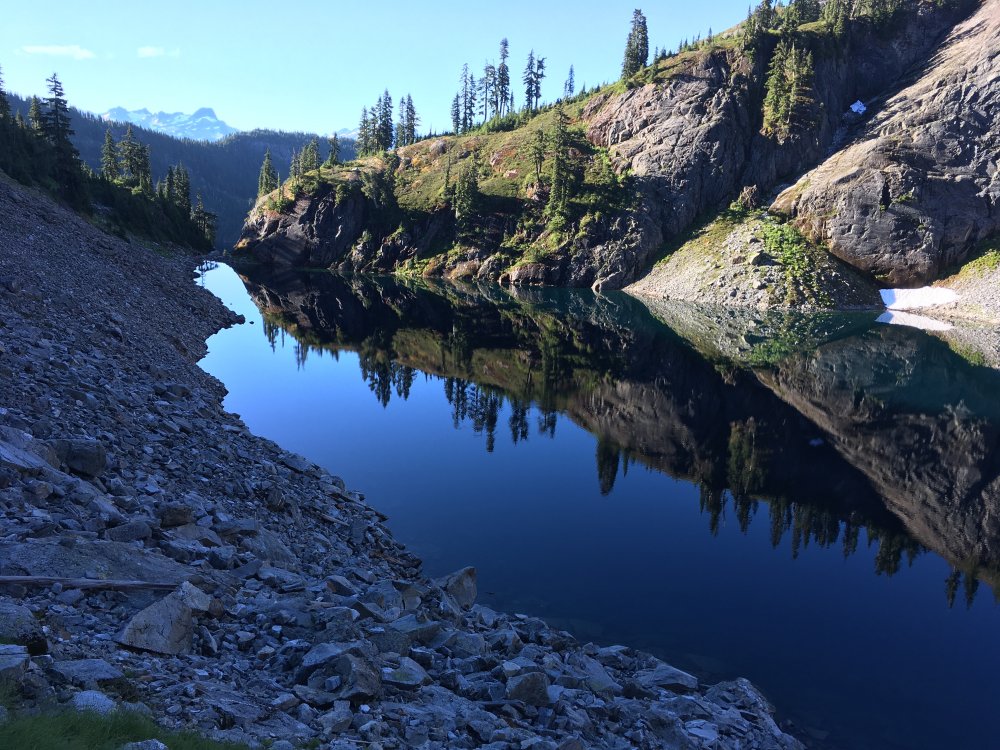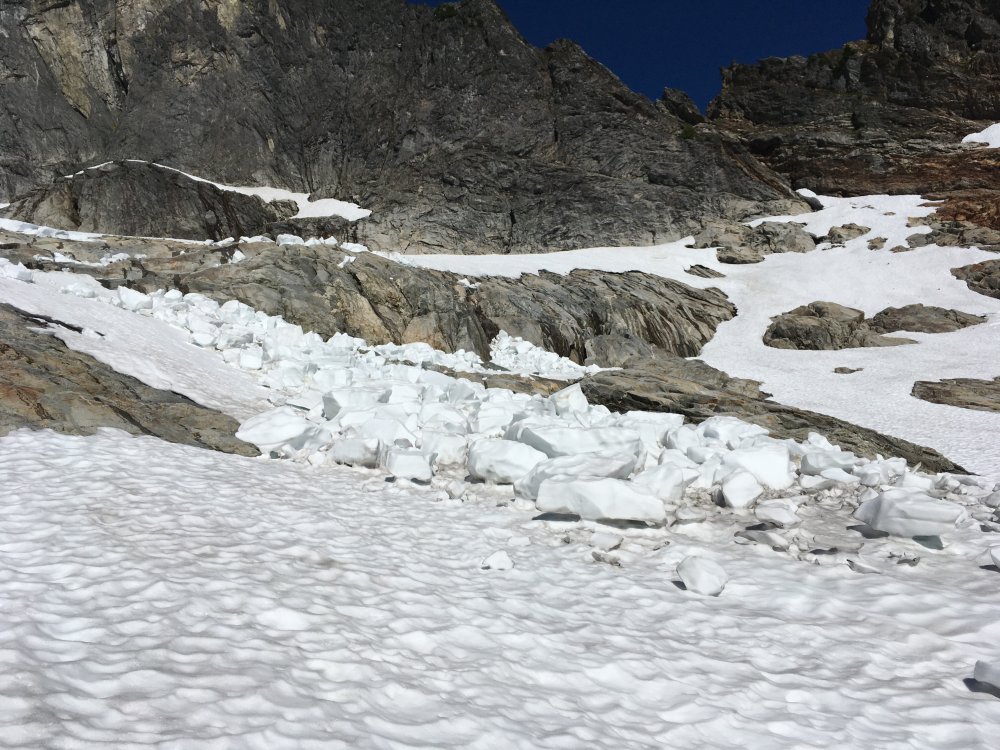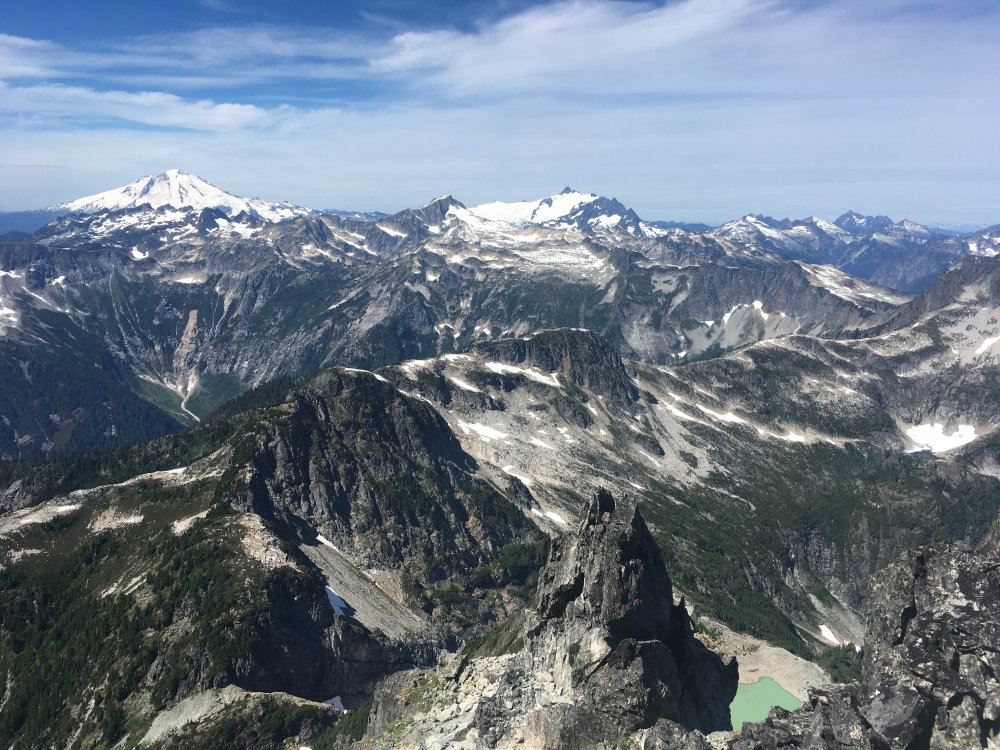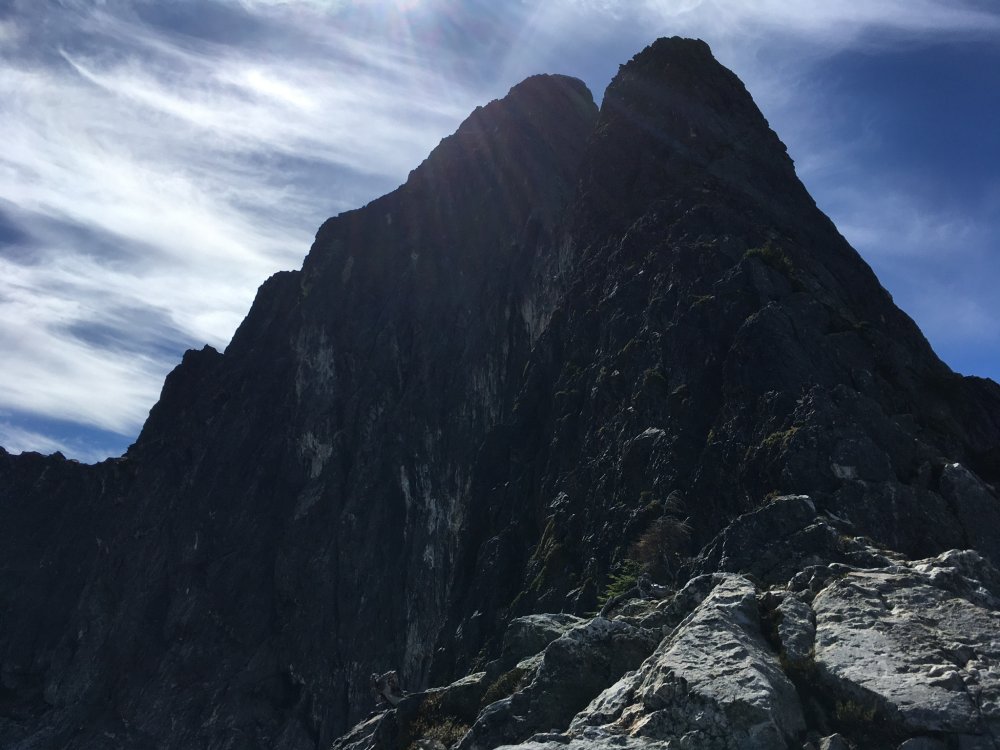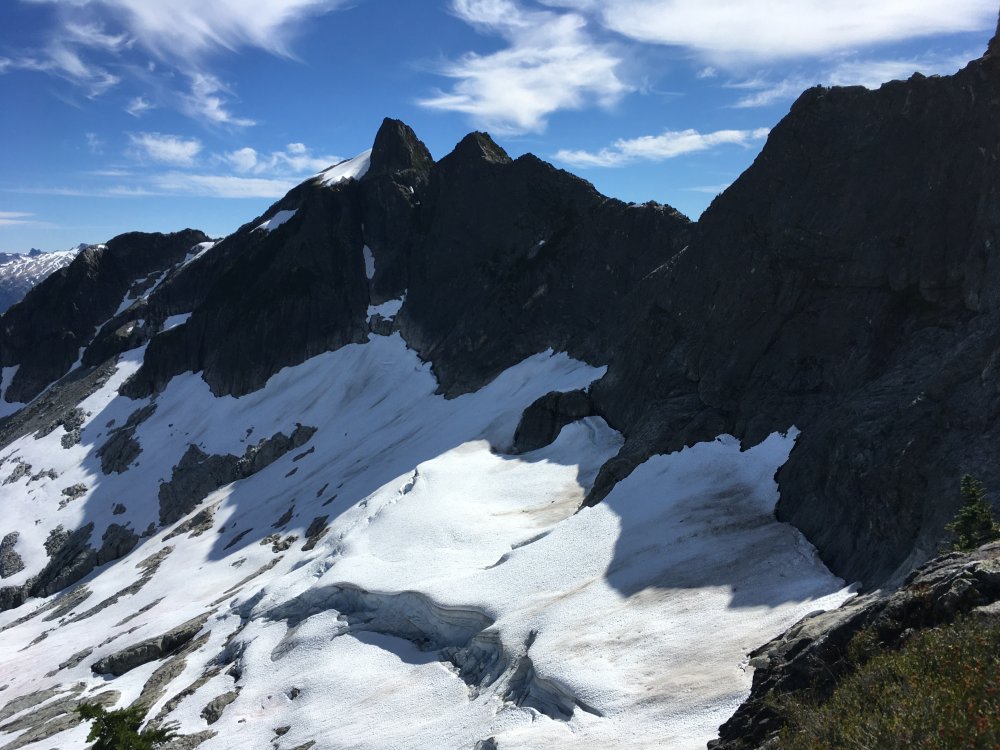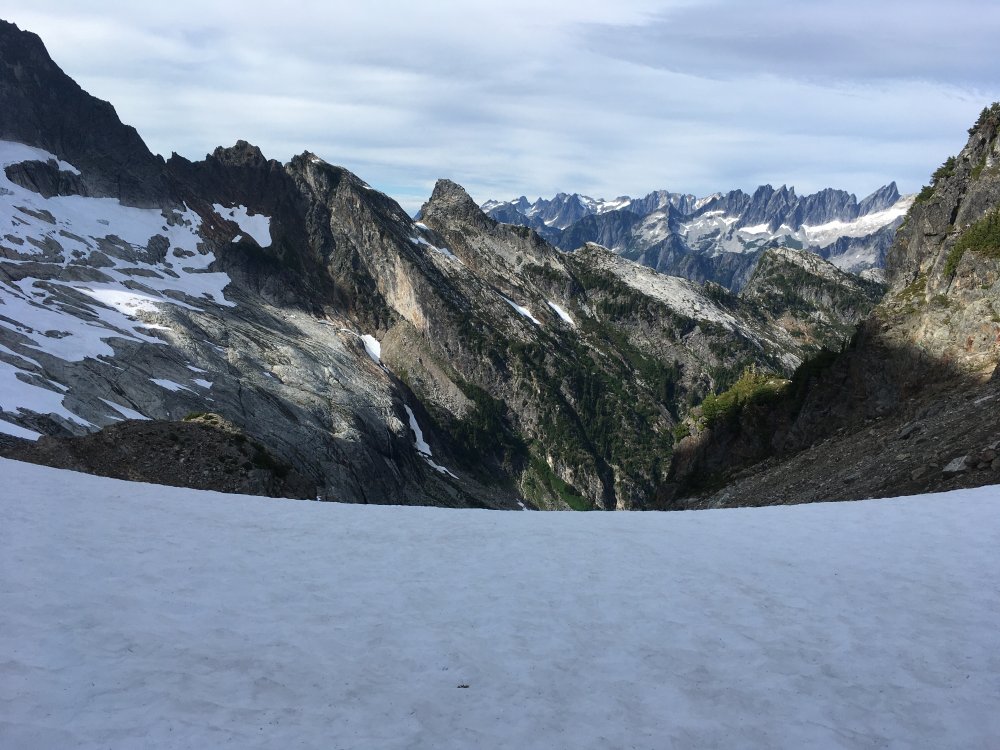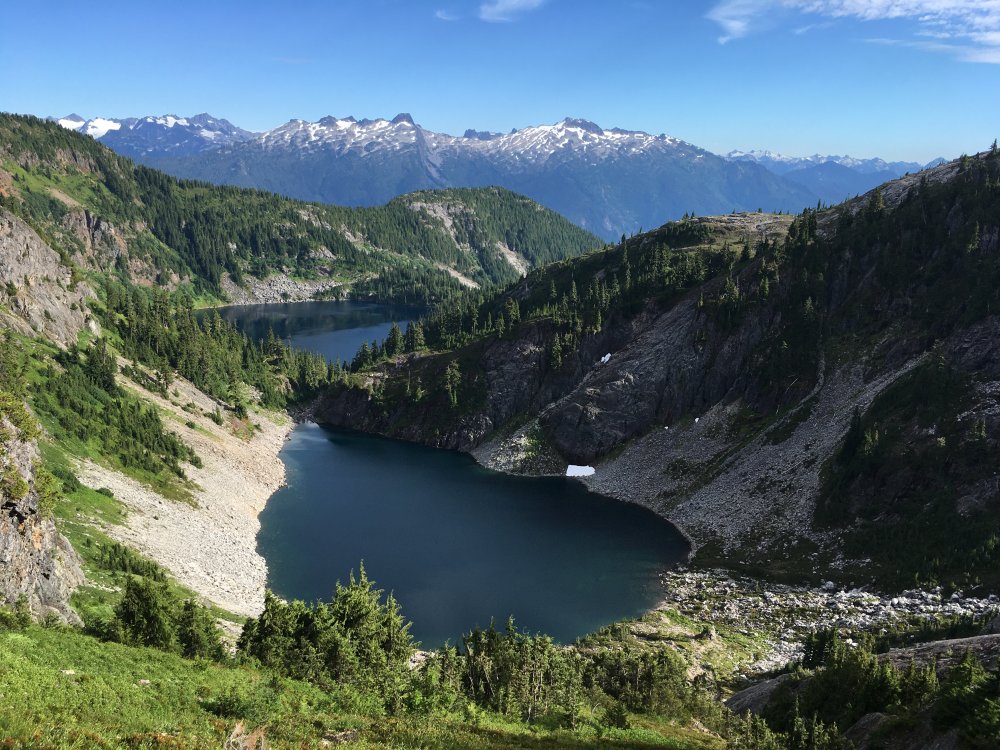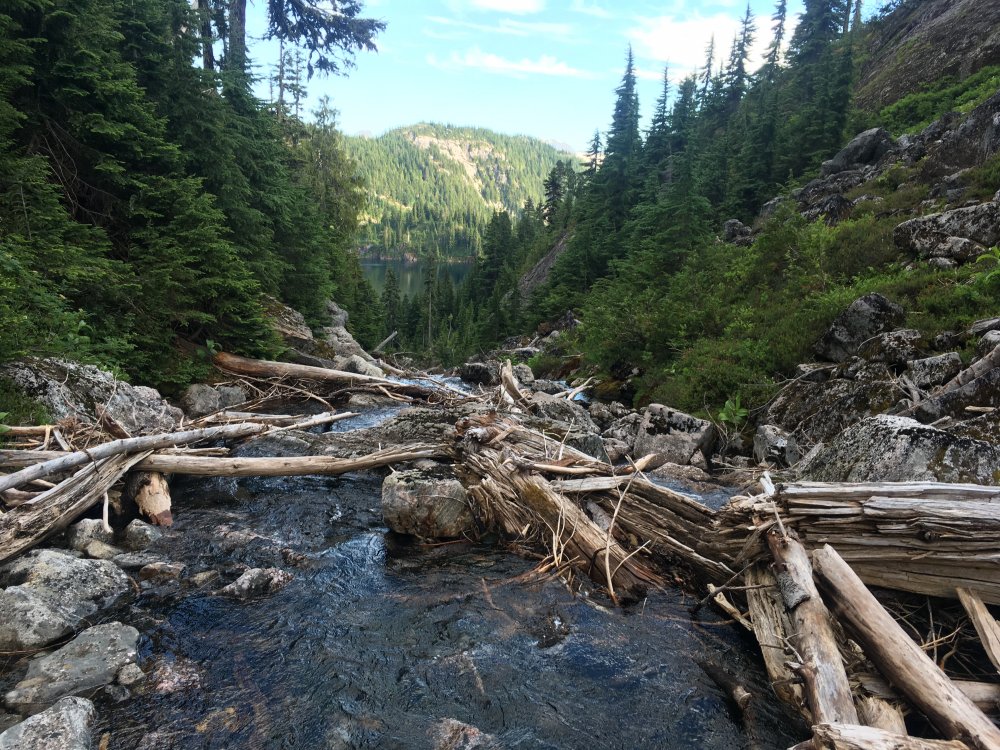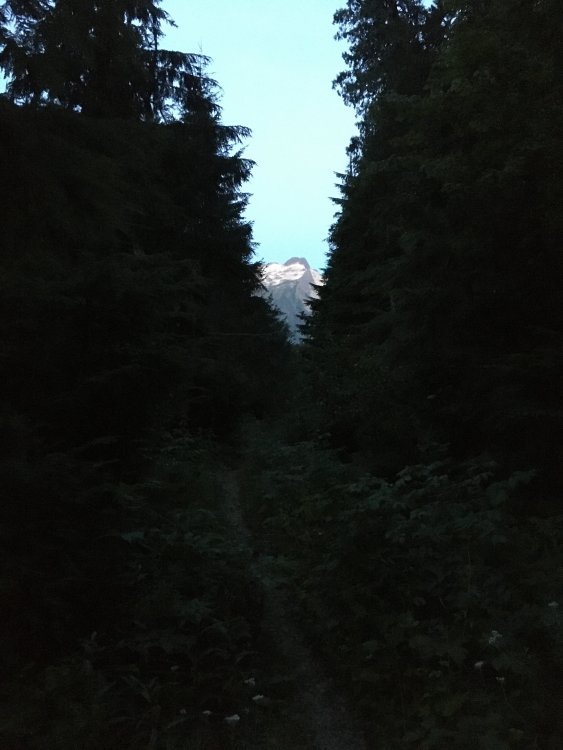Leaderboard
Popular Content
Showing content with the highest reputation on 08/28/20 in all areas
-
Trip: Twin Sisters - Obscurities Redux Trip Date: 08/23/2020 Trip Report: It's been a long time since I posted a trip report and even longer since I've gone explorer-ating in the Twin Sisters Range. Twelve, twelve! years ago Dave and I pushed, pedaled and slogged our way into the basin between the Twin Sisters to climb some nice rock on the obscure Block Tower. Obscurities The block is split clean through by a hand size crack, and while we had climbed the very short east face, the west side was much larger and steeper. I always wanted to go back but the approach-to-climbing ratio is pretty excessive and that logging road is just a soul sucking grind, particularly loaded down with a full rack. But in twelve years the world changes and e-bikes, well if not invented, at least became far more ubiquitous and I reached the point in life where one ended up in my garage. Plenty nice around town but it fundamentally transforms the experience of these long logging road approaches. The dreaded grind now feels like a casual ride to Sunday Farmers Market. Once you ditch the bike your legs are still fresh. Climbing the North Twin has become a casual afternoon jaunt. Highly recommended! So with a different friend we rolled in less than 45 minutes. The path into the basin seems far more beat in than it was ten years ago and people were scattered around in ways I had never seen. Really it's rather insane how busy everywhere has gotten, but I digress. As for the climb. The west face of Block and Arrowhead Towers are somewhere between 350'-400' tall and the rock quality is generally very good. We climbed two pitches (red) of low 5th-class ramps leading up and right to the much steeper upper half of the route. The first pitch was marred by a very chossy and unavoidable 3rd class gully. A far better start would be up clean north-facing slabs to the right of the tower (blue) to where you could scramble back left to below the headwall. The head wall was probably slightly less than 200' tall. You could do it in a single pitch but there's a perfect belay ledge at the base of the final splitter if you want to share the goods with your partner. The third pitch started out easy and a bit brittle. Fortunately rock quality improved as the angle increased. I stayed left of a very large detached block and climbed slightly overhung jugs with intermittent gear into the left of two parallel crack systems. It was heady but adequately protected. The final pitch is probably 40' in length but has absolute hero jamming through overhanging bulges. Both were maybe 5.9? Good stuff. A short rappel (make sure to TR the rap line) and a steep but easy scramble led down onto the glacier. From the col a series of 3 well-established raps led back down to the base of the climb. A nice climb, I'd go back. Other potential still abounds. Pitch 2 Pitch 4 From the Basin - Arrowhead Left & Block Tower Right Gear Notes: Doubles of small cams, single set #1=#4 maybe an extra #2 Approach Notes: E-bikes2 points
-
Trip: Abernathy Peak - Northwest Ridge Trip Date: 08/22/2020 Trip Report: Abernathy Peak 8321’ Trip Report – August 22-24, 2020 I climbed Abernathy Peak, the Northwest Ridge Route, over the weekend. This route can be done in 2 long days, I started late so I stretched it into a third day. The weather was perfect all weekend 70’s – 80’s. I started at the Cedar Creek Trailhead off Hwy 20 about 5 miles West of Mazama. I went up Trail 476 (Cedar Creek Trail) about 8.5 miles. At 5600’on the trail I took a hard left off the trail heading East along the 5600’contour line heading toward the South Fork of Cedar Creek. The bushwacking on this approach is pretty nice by Cascade standards. Most of the brush is waste deep and not super thick, so navigation was pretty easy. Once to the South Fork of Cedar Creek, I follow up the East side of the creek to Lamont Lake (6640’). Getting up to the lake requires some work, either a loose rock gully or some Class 3 rock. The camping along Lamont Lake is fantastic, lots of room and flat areas for tents. Just before heading out in the morning from the lake I was serenaded by a pack of coyotes for about 30 seconds from somewhere on the other side of the lake. They must have felt that it was a glorious morning too. I climbed up a gully on the Southwest side of the lake that lead to the Northwest Ridge leading to Abernathy Peak. The gully is loose rock and steep up the middle but there is a goat trail off to the right side which is a better route. Once on the Northwest Ridge to Abernathy the travel is very nice, lots of potential for camping. About halfway to Abernathy Peak you will start hitting 2nd & 3rd Class rock that will take you to the summit. Some of the rock on the ridge is exposed but fairly solid. There are a couple plateaus along the way up that you could camp on. Overall the climb is very nice with decent views and you get to checkout some history in the old mining area. The trail approach is nice with several camping options along the way. Most people on this trail are day hikers, I was the only climber in the area this weekend. Some Tips and Notes: 1. There are several camp spots along the Cedar Creek Trail & great camping at Lamont Lake. 2. The bushwacking to Lamont Lake is not bad compared to the Westside of the Cascades. 3. There is about 600’ vertical of steep gully or Class 3 rock to get to Lamont Lake by way of the South Fork of Cedar Creek. There may be an easier way but this was fine for me. 4. There is no water on the Northwest Ridge to Abernathy so bring what you need from the lake. Travel Time for reference: Day 1 (TH to Lamont Lake), 7 hours – Day 2 (Summit & back to lower camp off trail), 11 hours – Day 3 (back to car), 1 hours. Gear used: Trekking Poles, Helmet, Full Gaiters, Work Gloves. The camping at Lamont Lake is very nice, worth the bushwack! Gully climb up from Lake Lamont to the Northwest Ridge of Abernathy Peak. I climbed the gully closest to the 1st pointy peak, you can see the goat trail at the base of the peak. Northwest Ridge to Abernathy Peak. Nice relaxing ridge climb. Some old mining equipment along the route. Summit View - A good peak to plan other climbs from. Gear Notes: Trekking Poles, Helmet, Full Gaiters, Work Gloves. Approach Notes: Trail 476 (Cedar Creek Trail). Bushwacking to Lamont Lake.2 points
-
Trip: Mount Challenger - Eiley Wiley Ridge Trip Date: 08/17/2020 Trip Report: 3rd time's a charm.... After a failed attempt in July 2019 (Via whatcom glacier) and getting stuck in a whiteout on Whatcom peak with thunderstorms moving in.... ...and a cancelled attempt July 2020 with a forecast of non-stop rain and snow, we finally had a window to try Challenger via Eiley Wailey. We made a third attempt on “Wilakin-ghaist” almost 161 years (and a week) after it was first sighted by swiss born engineer Heinrich Custer (Reading “A Range of Glaciers: The Exploration and Survey of the Northern Cascade Range” by Beckey is a great way to get stoked for the climb!) For late season we opted for the Eiley Wiley approach and researched the stories of those who went before. Many thanks to those who posted before with their beta on the legendary Eiley Wiley schwack including Manacus, ncascademtns, gum, David_Zeps, Ian Lauder, and others. We found the following maps to be the most helpful and accurate for the traverse route of Eiley Wiley (forgive me, I didn’t keep track of who posted them, but thank you): Day 1 - Ross Lake boat ride to Big Beaver and on to Beaver Pass camp for a ~16 mile day. Chugged two liters of water between each campsite (39 mile, Luna, Beaver Pass) in the heat and listened to a tree fall at Beaver Pass and the distant rockfall up Access Creek and Luna Basin. 9 hours Big Beaver to Beaver Pass A glimpse of Challenger from the trail. Eiley Wiley ridge on right. Day 2 - The Eiley Schwack. Fearing yellow jackets, thorns and other horror stories we brought hearty bushwhack gloves and appreciated them. Having read several trip reports of this schwack, and now having done it two different ways, I can safely say there is an easy way to do this with minimal bushwhacking. Instead of telling you about another story of cliffing out, branch belays, new vocabulary, and slips and tumbles, I’ll describe what I think is the best route. If you look on the USGS map there are two clear drainages that shoot straight down the ridge east/west towards Beaver Pass. Most of the climb should take place on the spur between these two drainages. The USGS map shows the drainages you want to be between (but the shelter and campsite locations are incorrect and actually south of the start) IanLauder’s trip report was almost perfect with this one (thank you!) https://cascadeclimbers.com/forum/topic/103565-tr-mount-challenger-standard-route-07252020/?tab=comments#comment-1159784 Except that the climbers’ trail doesn’t cliff out, it was just hidden to the north This aerial imagery shows you the drainages and their position relative to Beaver Pass campsites. Ignore the side trips of exploratory bushwhacking. Directions uphill: From Beaver pass campsite, go north on the trail ~100-200 feet and then turn west towards the ridge and bushwhack downhill across the Beaver Pass drainages until you gain the Eiley-Wiley slope. Your goal is to get on the spur that rises between the two drainages. Once on the spur, the approach is nice open timber for ~700’ gain. The spur is ~100 yards wide and you can see the drainages on either side as you go up in the timber. Looking down the open timber At approximately ~4300’ you will hit a cliff. Go right (North) around the cliff and locate a climbers trail up and around it. Continue through open timber until ~4880’ where the spur cliffs out again. Look right (North) again for a boulder drainage ON THE SPUR. Not the main drainage further to the north. Work up the boulder drainage until ~4950’ where the boulder drainage pops out on a little clearing hillside on top of the cliffs. This is where the climber’s trail begins and goes until ~5180’ where you find your third cliff set Looking down the boulder drainage Here, go around the cliff left (south) and transition off the spur to the left (south), into the drainage where the climber’s trail continues up the drainage, and up left (south) onto the next spur until you reach the heather meadows at `5600 and end at a small campsite. Please enjoy this handy dandy map of the route UP: Once above the bushwhack. We enjoyed the alpine, heather meadows and stopped for lunch. 4 hours - Beaver Pass to 5600’ meadows. The climber’s trail leads to the eastern headwall of Eiley Wiley Ridge and puts you at the top of a large steep heather/grass gulley that begins the heather traverse. The general goal is to traverse a series of spurs on the south side of the main ridgeline around the 6400’ - 6200’ level. Along the way to Eiley Lake (~6126’) you’ll discover the most beautiful cascading pools trickling into a waterfall. This is the first water we found from Beaver Pass. I carried 4 liters to get here and was parched. These pools are some of the most amazing I’ve seen with a great view of Luna and the cirque. One pool even has its own drain like a bathtub into the next pool. End of Eiley/Wiley meadows at 5600’ meadows to pools - 5 hours. We made camp on two spots at Eiley Lake an hour later. Total travel time Beaver Pass to Eiley Lake ~10 hours. No water from Beaver pass until the pools. Day 3 - We opted for a 0300 wake up with a 345 departure from Eiley lake in pouring rain and navigated past the saddle to Wiley lake and up the eastern slopes of PT 7374. Crampons were needed on the exposed ice of the slopes. We found the notch recommended on the south side of PT 7374 and had no trouble getting through the notch. Once through, stay high and go north to the other side of the peak where heather benches await that drop down to Challenger saddle. Don’t drop all the way down the loose rock gulley. the notch at PT 7374 west side of the notch at PT 7374, go down ~40 feet and then traverse north on rocky ledges Whatcom Glacier and Whatcom Challenger Glacier from Challenger Arm Reached Challenger Arm by 0800 We pushed up in the rain, whiteout, and were able to ascend Challenger Arm and past the bergschrund without incident. I punched thigh deep through one crevasse. The snow arete/knife ridge to the summit block was very sharp, but we were able to walk it all the way to the end. A picket was essential here. The snow arete leading to the summit block We reached the summit block from Challenger arm in less than two hours and scrambled over to the base of the rock pitch. After clipping two pitons and placing a nut, my partner couldn’t find any foot purchase on the wet rainy rock at the crux. After a slip or two, we decided we had pushed our luck enough, climbing in the rain and whiteout clipped to a piton that was likely pounded in 40 years ago with little chance of rescue should things go south. “I climb to go home” is my motto, and just getting to this point was truly an incredible experience. We called it a summit and safely descended. the weather improved slightly and for a brief moment I saw the summit from afar. It was also at that moment that my partner had to self arrest near PT 7374 and I set loose a very large loose boulder behind me. It was becoming apparent we were not welcome. Wiley lake seemed welcoming enough…. ...for a dip However on the way out, traversing the outflow of Wiley Lake, I heard a large cracking sound and immediately jumped off the snow area I was on only to find it collapse into the lake. I now know what a collapsing snow structure sounds like We made our way back to Eiley Lake camp to call it a 12.5 hour day camp to camp and crashed. Day 4 - Return traverse along Eiely/Wiley ridge. Crossing the steep heather in howling wind and rain with heavy packs was the hairiest part of the trip. Routefinding was difficult and there are many places where a slip would lead to an unpleasant tumble. a rainbow awaited us at the end of the ridge. The Eiley schwack back downhill was vastly different than going up, as everything was wet. If you can do this bushwhack dry, it is highly recommended. I know it sounds obvious, but it was such a vastly difference experience. A roaring fire at Beaver Pass dried us out just in time for more rain and simultaneous air mattress failures. Day 5 - the long walk out back to Big Beaver for the boat ride home. 9 hours out. We encountered four parties headed in to Luna on our way out. FYI, National Park trail crews were out working the Big Beaver trail as we were out there. They have done a fantastic job clearing brush all the way to Beaver Pass. They haven’t touched Little Beaver yet, and didn’t last year either when we were there, so it’s likely still an overgrown mess. Many thanks to their hard work. A true cascade experience in BIG mountains. Gear Notes: 5 nuts, runners, pickets, glacier gear Approach Notes: Early season - Whatcom Glacier Late season - Eiley Wiley1 point
-
Trip: Three Sisters Marathon - Standard Route(s) Trip Date: 08/22/2020 Trip Report: Summary: Drove over to Pole Creek from Portland on Friday 8/21, even though the USFS website says the area is closed. Based on the fact that there were 50 cars at the trailhead, no one was fooled. My timeline is below. Certainly not bragging, but perhaps indicative of what a normal person could expect as opposed to the athletes on this site. I think I went the way most do. Up the SE Ridge of North, down the S Ridge across the snow and up Middle, down the S side of Middle and up the N Ridge of South. 4:00am - Departed Pole Creek Trailhead 4:30am - Begin bushwhack just past Soap Creek (lots of windthrow) 9:03am - Summit North Sister 12:12pm - Summit Middle Sister 5:06pm - Summit South Sister 7:56pm - Back at Camp Lake 11:45pm - Back at car at Pole Creek 11:46pm - First sip of cold beer all day (Russian River Blind Pig IPA) 11:47pm - Remove shoes 3:30am - Arrive home in Portland Beta: There is a lot of windthrow after you leave the trail near Soap Creek. In the dark, it is harder to pick your way through. There is no snow or ice on the Traverse or in the Bowling Alley. I climbed up the right side of the bowling alley on the "more solid" rock that looks back down over the Traverse. There is a piece of pro that someone left mid-traverse, but they forgot my fixed line. There are at least two fresh slings on the main rap rock at the top of the Bowling Alley. And, over on the North Ridge of South Sister, someone was nice enough to leave a rope, leading around the last band of rock, just below the lower-angle section at the top. Slings there not quite as fresh! Observations: I'm getting way too old for this. This is very likely the last time I go up North Sister. After you get about 8 miles from a trailhead, there are very few people who are not really fit. There are lots of butterflies up top right now! Now, I totally understand why people drop a car at the other side of South! Photos: Took a few, but I will spare you the selfies of my ugly mug holding up one, two, and three fingers at the top of each hill! Gear Notes: Tennis Shoes and water Approach Notes: Pole Creek TH up SE Ridge of North Sister and onward1 point
-
Trip: Forbidden - E Ridge Direct Trip Date: 08/26/2020 Trip Report: Deb and I climbed the E Ridge Direct route on Forbidden on Wednesday. It was an absolute blast, a perfect day of climbing! We were able to get Boston Basin permits, and although sure, you can do these climbs car to car without issues, why not camp in such an amazing place if you can? Deb hadn't been up the Boston Basin trail before and I was SHOCKED at how much more defined the trail was and how much easier it was this time than last May carrying my skis up. Who woulda thought?! We got up there in a little over 2 hours and enjoyed the sunset light and drank some beers I'd packed up. No skeeters! And so little snow. In the dark, we watched as SIX headlamps slowly made their way down... wow. I stayed up to see what had happened. Turns out, nothing! "Just a lot of parties on the west ridge, traffic jams on rappels..." Dang. We got moving a bit before 7 the next day and although we brought aluminum pons and light axes, the super hard snow gave us reason for finding a more creative route around the snowfields up to the choss and notch where the route starts. It took us about an hour and a half or so to get from camp to the notch and soon we were simulclimbing on excellent rock along an amazing ridge in such an incredible place. SO FUN! I took us as direct a line as possible, over the 5.7 stuff, some awesome knife-edge type ridge walking, and then we stopped to belay the 5.8 (it was just a couple bouldery moves) final gendarme bit. It's cool that most of the little towers can be downclimbed; it's too bad there is the one mandatory short rappel. I was happy that I was able to lead everything in my approach shoes without a problem. Deb took the rack and we simuled the rest of the ridge to the summit! It took us about 4 hours from notch to summit, which was definitely on the longer side of what I expected, but fine! Summit views were of course amazing.... The East Ledges descent was not a problem at all and Deb and I were both scratching our heads about how it has such a nasty reputation. Maybe if you got seriously off route it could be scary? I guess it all depends on experience, exposure to exposure, etc. etc. but for us, it was no problem. All the raps pulled cleanly and nary a pebble fell upon us. We got back to the notch approximately 2 hours from leaving the summit. The snow was soft at this point, so we took a snowfield down, and then avoided 4th class terrain by descending further to the west and then onto slabs. On the way out, we came around a corner to see a BEAR which was super awesome. He looked young to me, maybe 1-2 years old? Cutie pie. He was startled and trotted off, then we watched him cross Morning Star Creek and then on the other side, paw some boulder off and dig around. A fantastic way to end our time in Boston Basin.... Camera came out a bit late...can you spot the bear? I enjoyed this climb much more than the West Ridge. I think I will definitely be back to repeat it. And we got it ALL TO OURSELVES! Thank you, Deb, for being a fantastic climbing partner Gear Notes: Lots of double-length slings! We brought a 60m single rope which we shortened for the simulclimbing -- I think this was actually the right choice for us, over doubling a 60m twin/half. Medium rack to keep the simuling going... but lots of horns and towers and things on the ridge, so I felt like a lot of the terrain was providing protection! Approach Notes: Up, over, up, over, up.1 point
-
Trip: Triumph - NE Ridge Trip Date: 08/23/2020 Trip Report: Soloed the route c2c yesterday. Driving up Saturday night I passed cars at many pullouts near the trailhead so I was shocked to roll into an EMPTY PARKING LOT. Approach was smooth and shaded until the glacier crossing. Nearing the notch I heard voices up ahead. I thought I’d try to catch up with them at the base of the 5.7 pitch and check if they’d be willing to trail my rope and give me a quick belay from above that crack. Since they didn’t sound very far up the route that gave me some time for exploration. My first diversion was trying to take the snow tongue as a short cut to the notch, but it ended up being quite tall and steep on all sides, so I descended back the way I came, carefully stepping down into the west side near the start of a granite ramp. Several years ago I had made it as far as the bivy ledge with a friend who succumbed to some minor heat stroke (very hot day). We spent the night there and headed back the next morning instead of climbing the route. I remembered the start of the route being crappy, so this granite ramp caught my eye. Maybe a better bypass route could be found along it. I traversed along it for quite a ways, passing an anchor (maybe for bailing?) until it petered out. Tried a few spots to get up towards the ridge but it just didn’t quite go, everything seemed to have 1 or 2 sketchy 5.7-5.8 face moves to get off the ledges. So I backtracked to that anchor. I tried climbing above it, initially on good low 5th knobs but again hit a dead end. I went down and East again, almost back to the start of the route. After all this wandering for an hour or so I was able to bypass the first pitch, but no more. Back on route I quickly caught up with the pair ahead just as they were nearing the 5.7 pitch, as planned. I asked about the belay but it was a guide and client and they were planning to bypass it to the right. Thin face traversing + route finding didn’t sound safer to me than a straight forward obvious crack, so I passed them there and climbed up to the crack. I hope I didn’t freak them out too much climbing it. People don’t usually mention taking a #4 on this route so I had hoped a #3 would be big enough. It wasn’t, really. You can protect this part with smaller pieces by sticking them deeper in the crack, but doing so feels a little insecure, especially while soloing (there’s was a fixed .75 that I automatically starting trying to free for 3 seconds before remembering where I was and what I was doing ). For those inclined to solo the route, plan on about 15 ft of 5.5ish to start, then another 12 ft or so of 5.7. And bumping up a #4 as you go might decrease your risk. Near the summit I spied a corner with hand and finger cracks that looked more appealing than the loose and heathery ledges surrounding it. It was probably 15 ft, 5.6. There was a loose microwave at the top of it that I took care to step over. Such good summit views there. Downclimbed what I could, with 5 raps along the way. Like many have noted, it usually takes longer to descend than ascend this ridge and that was the case for me if you don’t count the granite ramp exploring I did at the start. About 20 minutes longer, I think. Had a very nice plunge at the upper lake (2nd one, not the third one higher up). It was too cold to swim for more than a few seconds. Very refreshing though! Smooth sailing from there. Made it to the car at 830 just as it was getting dark. So it was 14.5 hours including time for exploring, enjoying the summit, and a dip at the lake. Gear Notes: #2 (unused), #3 (used) wish I had a #4 instead 60m for raps Approach Notes: Straightforward1 point
-
http://library.alpineclubofcanada.ca:8009/book-acc.php?id=CAJ073-1-1990#page/80 Here is a link to the story, was actually in December not February and the route is called Surrogate Panama http://library.alpineclubofcanada.ca:8009/book-acc.php?id=CAJ073-1-19901 point



.thumb.jpg.d8d6db40947cc944f6d3d87de772c58e.jpg)

